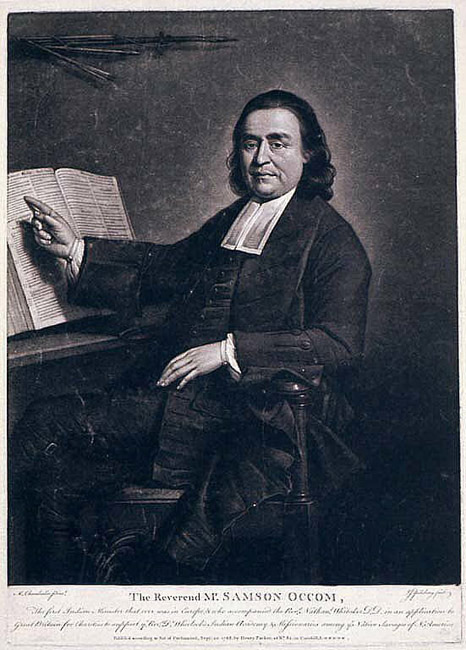Born in 1723, Samson was a member of the Mohegan nation from near New London, CT and became a Presbyterian minister. Occum was the first Native American to publish his writings in English, and also helped found several settlements, including what ultimately became known as the Brothertown Indians. Together with the missionary John Eliot, Occom became one of the foremost missionaries who cross-fertilized Native American communities with Christianized European culture.
Elliott published the first Bible in the US, which just happened to be written in Algonquian.
Born to Joshua Tomacham and his wife Sarah, Occom is believed to be a direct descendant of Uncas, the notable Mohegan chief.
In 1743 at the age of 20, Occom heard the teachings of Christian evangelical preachers in the Great Awakening. He began to study theology at the “Lattin School” of Congregational minister Eleazar Wheelock in 1743 and stayed for four years until leaving to begin his own career. In addition to improving his English, Occom learned to read and speak Hebrew. As a young man, the only book he owned was the Bible. From 1747 until 1749, Occum worked under and studied with the Reverend Solomon Williams in New London, Connecticut.
From 1749–61, Occom became a teacher, preacher, and judge to Pequot Native Americans in Montauk, eastern Long Island. He married Mary Fowler, a local woman, in the fall of 1751. Occom helped the Pequot to assimilate and adopt European-style houses, dress and culture.
He was officially ordained a minister on August 30, 1759, by the presbytery of Suffolk. Occom was never paid the same salary as white preachers, although promised that he would be. The “Society in Scotland for Propagating Christian Knowledge” also gave Occom a stipend, but he lived in deep poverty for much of his life. In 1761 and 1763, Occom traveled to the Six Nations of the Iroquois in upstate New York to preach. Winning few converts, he returned to teach at Mohegan, Connecticut near New London.
Meanwhile, in 1754, Wheelock had established an Indian charity school in Lebanon, Connecticut with a legacy from Joshua Moor, among others. Wheelock persuaded his former pupil to travel to England to raise money for the school. Occom preached his way across Britain from February 16, 1766, to July 22, 1767, delivering between three and four hundred sermons, drawing large crowds wherever he went, and raising over ₤12,000 (pounds) for Wheelock’s project. King George III donated 200 pounds, and William Legge, Earl of Dartmouth subscribed 50 guineas. However, Occom on his return learned that Wheelock failed to care for Occom’s wife and children while he was away. Furthermore, Wheelock moved to New Hampshire and used the funds raised to establish Dartmouth College (named after the generous aristocrat) for the education of Englishmen, rather than Native Americans as originally promised to Occom.
This disappointment was followed by the Connecticut Colony’s ruling that the Mohegans would not be compensated for land they sold to the colony. The colony then backed an unpopular candidate for Mohegan Sachemship. This led the Mohegans to decide that no Sachem was better than a colonial puppet. With the Tribe increasingly penniless and powerless, Occum accepted an invitation in the 1780s for his group to resettle with the upstate New York Oneida. He hoped their new home in Brothertown, New York would free them from additional disappointment. His legacy for the Mohegan people who remained in Connecticut was a reputation for being Christianized, which helped them avoid later relocation, although not forever.
Upon his return from England, Occom lived with the Mohegan. After Wheelock’s betrayal, Occom worked to organize Christianized Indians of New England and Long Island into a new tribe, located in western Connecticut. Under continuing pressure from settlers following the American Revolutionary War, in 1785 they migrated at the invitation of Christians of the Oneida tribe to their reservation in central New York state. Occom, his son-in-law Joseph Johnson (Mohegan)(a messenger for General George Washington during the American Revolution); and his brother-in-law David Fowler (Montauk) led the emigrants who built a new settlement called “Brothertown” (originally nearby Waterville, NY). The Oneida also invited other Christian Indians to live with them, namely the Stockbridge Mohican from western Massachusetts and two Lenape groups from southern New Jersey. The Mohicans founded what they called New Stockbridge in New York, near Oneida Lake. Occom not only assured these villages received civil charters in 1787, but also evicted white settlers from Brotherton on April 12, 1792.
Occom died on July 14, 1792, in New Stockbridge. He is buried just off of Bogusville Hill Road outside of Deansboro.
In the 1820s, many Brothertown Indians and some Oneida accepted payment for their land from New York State and removed to what is now known as the Town of Brothertown in Calumet County, Wisconsin. In the modern era, the Brothertown Indians petitioned the federal government for recognition as a tribe, but were denied and have appealed.


I would like to learn more about the Brothertown DNA, especially if there is a project.
Not that I know if specifically. Just the American Indian project.